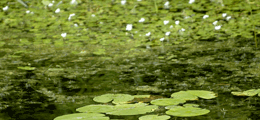|

The brilliant array of these white flowers with their bright yellow centres is worthy of the apparel of the Water Goddess Nymphea, who inspired the French name (nymphéa) of the common water lily. Its glossy leaves seem to have been designed to celebrate a grand occasion.
-------------------------------------------------------------------------------------------------------------------------

Behind the water lilies, you can see a gathering of many European frogbit. Their leaves resemble miniature pond lilies, and their striking white flowers stand out against the dark background of the aquatic plant community. The European frogbit was introduced in Ontario in 1932, and has been spreading throughout many wetland areas ever since.
-------------------------------------------------------------------------------------------------------------------------
Arrowheads, whose leaves resemble arrows, edge almost all the channels. These plants are particularly efficient water purifiers. They assimilate heavy metals into their tubers.
-------------------------------------------------------------------------------------------------------------------------
Cordate pickerelweeds can be found near the water lilies and arrowheads. They are often found in little islands of colour. The violet shade of its spike flowers adds to the beauty of the landscape, and attracts a large number of bees that come to gather nectar.
-------------------------------------------------------------------------------------------------------------------------
Common duckweed improves the quality of water, while contributing a protein-rich staple to the food supply of many animals.
-------------------------------------------------------------------------------------------------------------------------
In July, the vegetation throughout the aquatic plant communities becomes so dense it renders navigation difficult.
-------------------------------------------------------------------------------------------------------------------------
The supple leaves of the American tape-grass float just under the surface of the water, in very dense growths.
-------------------------------------------------------------------------------------------------------------------------
In 1905, the first specimen of flowering-rush was discovered in Quebec. Afterwards, this exotic species rapidly invaded marshes. Muskrats feed on its stems.
-------------------------------------------------------------------------------------------------------------------------
Introduced at the beginning of the 19th century, purple loosestrife has taken over wet meadows to the extent that native species have been pushed out of certain zones. Indeed, as attractive as they may appear, dense groupings of these plants almost completely exclude all other plants. Nearly one-quarter of the marshes and wet meadows of Lake Saint-Pierre have been taken over by purple loosestrife.
-------------------------------------------------------------------------------------------------------------------------
In olden times, cattails (typha) soaked in oil were used as torches during festivities. People ate their spikes and the flour extracted from their rhizomes.
When the wind blows through the marshes, the long leaves sway and ripple in the breeze, creating the illusion of a sea of plants, as far as the eye can see.
-------------------------------------------------------------------------------------------------------------------------
Growths of reed grass are almost as impenetrable as real jungles. These exotic plants are among the most invasive species in wetlands.
-------------------------------------------------------------------------------------------------------------------------
A network of roots, or a dead tree trunk, provides shelter for many animal species.
-------------------------------------------------------------------------------------------------------------------------
The red osier dogwood is so named because of its flame-coloured branches. These supple branches were used to weave baskets, to make bows and arrows. Its bark was used by natives as a sort of pipe tobacco, mixed with other plants, or as a medicinal infusion.
-------------------------------------------------------------------------------------------------------------------------
The climbing nightshade has delicate yellow and lilac-coloured flowers.
Beware its bright red fruit, it is very toxic!
-------------------------------------------------------------------------------------------------------------------------
During the summer season, vegetation is at its peak, providing visitors with a rich display of colours and shapes.
-------------------------------------------------------------------------------------------------------------------------
In the swamp, the level of humidity is very high. Carpets of moss cover fallen branches.
Links |